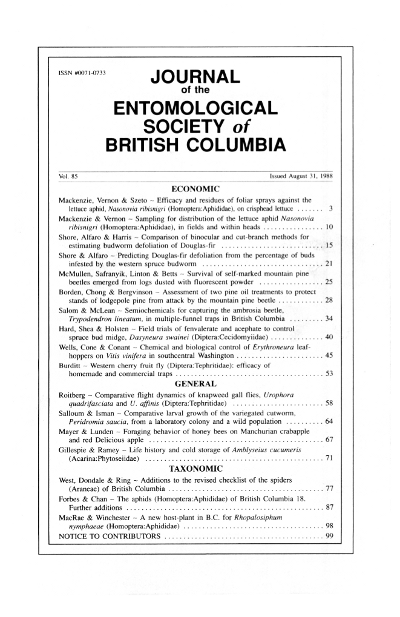Efficacy and Residues of Foliar Sprays Against the Lettuce Aphid, <i>Nasonovia ribisnigri</i> (Homoptera: Aphididae), on Crisphead Lettuce
Abstract
The systemic insecticides disulfoton. oxydemeton-methyl and demeton, were highly effective in controlling the lettuce aphid, Nasonovia ribisnigri (Mosley) (Homoptera: Aphididae), when sprayed on crisphead lettuce at the early stage of heading. Total residues of disulfoton, applied at 1.12 kg AI/ha and oxydemelOn-methyl at 0.56 kg AI/ha. diminished to less than 0.06 ppm 28 days after application, making these compounds strong candidates to replace the discontinued demeton. The local systemic compounds pirimicarb and methamidophos were intermediate in effectiveness between the systemics listed and contact insecticides such as endosulfan, mevinphos and parathion when applied to lettuce before the heading stage. Seven methods of applying methamidophos at 1. 1 kg AI/ha all provided equally significant levels of lettuce aphid control.Downloads
Issue
Section
License
Authors who publish with the Journal of the Entomological Society of British Columbia agree to the following terms:
-Authors retain copyright and grant the journal right of first publication with the work simultaneously licensed under a Creative Commons Attribution License that allows others to share the work with an acknowledgement of the work's authorship and initial publication in this journal.
-Authors are able to enter into separate, additional contractual arrangements for the non-exclusive distribution of the journal's published version of the work (e.g., post it to an institutional repository or publish it in a book), with an acknowledgement of its initial publication in this journal.
-Authors are permitted and encouraged to post their work online (e.g., in institutional repositories or on their website) prior to and during the submission process, as it can lead to productive exchanges, as well as earlier and greater citation of published work (See The Effect of Open Access).


